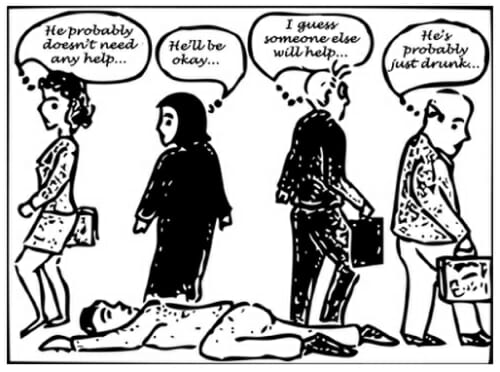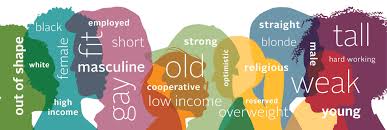Section 1: Student Conduct
Here you will cover:
- Bystander Intervention
- Consent
- Unconscious Bias
Bystander Intervention

Task 1: Watch the video
Task 2: Read the text
Be an Active Bystander
Anyone can be a bystander – every day we encounter events that happen around us. It’s inevitable that at some point we will see something happening where we instantly know it is not right, or that someone is in danger. When this happens we have a choice; we can say or do something (becoming an active bystander) or we can ignore it (remain a passive bystander).
By intervening, we let the person who is behaving inappropriately know that we have registered what they are doing and that their behaviour is unacceptable. If everyone in our community chooses to be an active bystander we can shift the boundaries of what is considered acceptable, we can stop problematic behaviour.
Learning to recognise problem behaviour and how to intervene safely is an essential skill. Examples of safely intervening could be anything from a disapproving look, interrupting, distracting or talking to the person displaying the behaviour in a non-confrontational way. Sometimes it may mean asking friends, staff members or the police for help with a situation.
Research shows that bystander intervention can be an effective way of stopping sexual assault before it happens, as bystanders play a key role in preventing, discouraging, and/or intervening when an act of violence has the potential to occur.
Before stepping in, try the ABC approach.
- Assess for safety: If you see someone in trouble, ask yourself if you can help safely in any way. Remember, your personal safety is a priority – never put yourself at risk.
- Be in a group: It’s safer to call out behaviour or intervene in a group. If this is not an option, report it to others who can act.
- Care for the victim. Talk to the person who you think may need help. Ask them if they are OK.
How You Can Intervene Safely:
When it comes to intervening safely, remember the four Ds – direct, distract, delegate, delay.
- Direct action
Call out negative behaviour, tell the person to stop or ask the victim if they are OK. Do this as a group if you can. Be polite. Don’t aggravate the situation - remain calm and state why something has offended you. Stick to exactly what has happened, don’t exaggerate.
- Distract
Interrupt, start a conversation with the person acting inappropriately to allow their potential target to move away or have friends intervene. You could try coming up with an idea to get the victim out of the situation – tell them they need to take a call, or you need to speak to them; any excuse to get them away to safety. Alternatively, try distracting or redirecting the situation.
- Delegate
If you are too embarrassed or shy to speak out, or you don’t feel safe to do so, get someone else to step in.
- Delay
If the situation is too dangerous to challenge then and there (such as there is the threat of violence or you are outnumbered) just walk away. Wait for the situation to pass then ask the victim later if they are OK. Or report it when it’s safe to do so – it’s never too late to act.
In an emergency, call the police on 999.
And remember, never put yourself in danger. Only intervene if safe to do so.
Consent

Task 3: Watch the video
Sex without consent is rape and can have devastating consequences. Everyone must seek consent responsibly.
Task 4: Read the text
Sexual Violence
Sexual violence is an umbrella term used to refer to different types of offences that can take place when consent to sexual activity has not been given. It covers a range of behaviours such as sexual harassment, sexual assault, domestic abuse, coercive control and rape. Sexual violence can happen to anyone regardless of age, disability, gender identity, nationality, race, religious beliefs, sex or sexual orientation.
Sexual consent is where a person has the ability and freedom to agree to sexual activity. A person can consent to sexual activity if they agree 'by choice and has the freedom and capacity to make that choice' (Sexual Offences Act, 2013).
Freedom
Freedom means not being controlled or manipulated in any way to agree to sexual activity. Coercive control is a form of domestic abuse that can happen between people in a relationship. It can involve sexual harassment or pressuring someone into sex. In a relationship or not, if any kind of physical, emotional or psychological pressure, abuse or force is used to coerce someone into any sexual act, then the person being coerced has lost their freedom of choice.
Capacity
Having capacity means the person can make and communicate a decision, understand the consequences and know they have a choice. If they cannot do this, they cannot give consent. If they are asleep or unconscious they cannot consent.
Permission is key, seek consent responsibly.
Acts of harassment and violence often come from established attitudes and beliefs about other people that can manifest into more serious acts of aggression.
Rape Culture
Rape culture is a concept that describes a situation where rape is normalised due to societal attitudes and beliefs. These beliefs are perpetuated through behaviours that include sexual objectification, victim blaming, slut-shaming and trivialising rape through jokes and banter.
Victim Blaming
Victim blaming is where people are told to change their own behaviour to avoid being assaulted or raped. They might be told to dress less provocatively, drink less alcohol, and not put themselves in risky situations. This can reinforce the belief that somehow it is the victims fault when they are attacked.
The only person responsible for an assault or rape is the perpetrator.
Everyone has the right to live, work and study in an environment free from the fear of harassment or violence.
Recognise your personal responsibility.
Unconscious Bias

Unconscious bias and implicit bias
We process a person’s ethnicity, gender, age and disability before we even know we’ve done it. At the same time we also link that person to all the supposed ‘knowledge’ we have of the category with which we have labelled them. The stereotypes and societal assumptions and personal experiences that have framed the category become linked to the individual.
Task 5: Watch the video
Task 6: Read the text
Unconscious bias is a term used to describe the associations that we hold which, despite being outside our conscious awareness, can have a significant influence on our attitudes and behaviour. Regardless of how fair minded we believe ourselves to be, most people have some degree of unconscious bias. The means that we automatically respond to others (eg people from different racial or ethnic groups) in positive or negative ways. These associations are difficult to override, regardless of whether we recognise them to be wrong, because they are deeply ingrained into our thinking and emotions. Acknowledging and taking responsibility for unconscious bias is not just a moral imperative, it is also financially and reputationally important. For HEIs, making biased decisions affects the recruitment and selection of staff and students, and the ability of those staff and students to achieve their full potential.
Congratulations!
You have now completed Section 1
